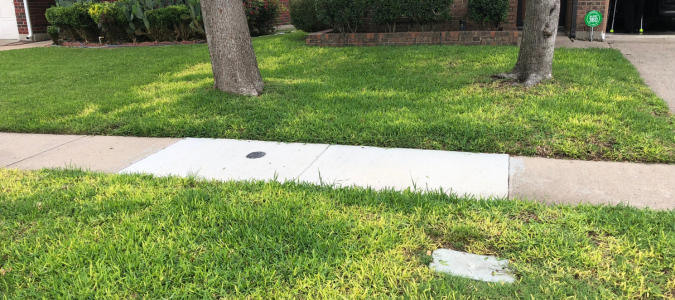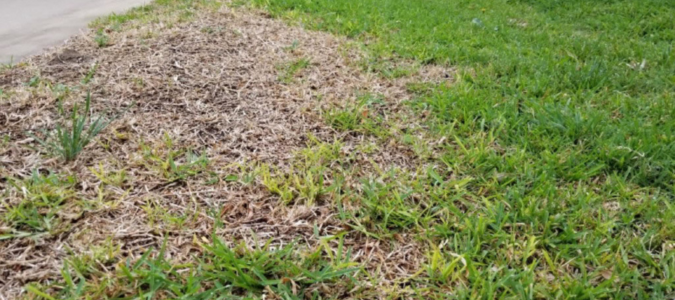For anyone who adores their yard, take-all root rot is one of the worst things to deal with. This disease puts all your time and hard work to waste, causing weak and dead patches in your yard.
If you’re worried about take-all root rot taking over your yard, here are the first signs to look out for. Remember that prevention is always better than treatment. If take-all root rot in your yard has gotten out of hand, don’t despair. A lawn service professional can restore it to its former glory. You can also schedule regular maintenance to ensure your yard is in tip-top shape.
Take-All Root Rot Symptoms, Causes, Prevention and Treatment
Root rot is a fungal disease that mostly affects warm-season grasses like bermuda, St. Augustine and zoysia grass.
Causes
This lawn condition is caused by a fungus that lives in soil. It is most commonly found in grass that looks diseased but can also disguise itself in healthy-looking grass. It lives in the layer of plant roots called thatch, stolons and decaying plant matter. Stolons are horizontally growing stems that are aboveground. Take-all root rot is most commonly spread when infected soil or grass is moved.
Symptoms
Most homeowners will notice signs of take-all root rot in the spring or summer when the grass emerges from winter dormancy. However, if the grass is stressed by heat, drought or shade the symptoms can appear at any time of year.
Homeowners will notice yellowish patches in their yard that will then turn brown and wilt. These patches can be anywhere from 1 foot to 20 feet wide.
Prevention and Treatment
Take-all root rot can be hard to control once it has taken hold of your grass, so prevention is crucial. Here are some tips to remember to keep your lawn healthy.
Don’t Overwater
There’s something therapeutic about watering your lawn, but don’t overdo it. Water your lawn according to a schedule that fits their needs. This step is especially crucial in the rainy season or colder months when soil takes longer to dry.
Overwatering can also deplete the soil of oxygen, which weakens the grass’ root system and can reduce its natural defense against diseases like take-all root rot. A lawn care specialist can help you determine the right watering schedule for your yard. Don’t hesitate to reach out to them for help.
Ensure Proper Soil Drainage
Making sure your lawn has proper drainage is an important step to prevent take-all root rot. Since stagnant water can reduce soil oxygen levels, it can weaken the grass and make it more susceptible to diseases.
For the soil on your property, you can tell it has good drainage when it becomes crumbly when moist. The small clumps should maintain their form instead of becoming muddy. Also, water shouldn’t remain on top of the soil for several hours after rainfall. Here’s a test you can conduct to test the soil’s drainage:
- Dig a hole in the soil around 12 inches deep and wide.
- Fill the hole with water and leave it. Come back the next day and fill it again.
- All of the water should be gone by eight hours.
- If the water drains slower than an inch per hour, you might have compacted soil, or it might have high clay content.
If you’ve tried everything you can to save your grass from take-all root rot to no avail, it’s time to call in the pros. Lawn care specialists have the tools and expertise to treat the disease and prevent it from damaging your yard even more. They can also help you with other lawn care needs, like understanding when to mow the lawn in the spring.
How To Fix Take-All Root Rot
Root rot is hard to fix on your own, which is why many homeowners turn to professionals for help.
It’s crucial to have a lawn care specialist’s help to reduce take-all root rot. They have the experience and tools needed to restore your lawn. The first thing they will do is lower the soil pH levels, apply fungicides and use top dressing, a thin layer of peat moss, over the surface of the grass. This will improve the soil quality and drainage and promote healthy grass growth.
Afterwards, a lawn care specialist will monitor and maintain the grass to prevent the return of take-all root rot.
The best way to prevent take-all root rot is to take good care of the grass. If the grass is under stress because of excessive shade, compacted soil, extreme temperatures or another condition that weakens it, take-all root rot becomes a serious issue.
Take-All Root Rot Versus Healthy Grass
Most homeowners can easily tell healthy grass apart from grass affected by take-all root rot. However, it can be difficult for homeowners to tell whether a lawn is dealing with take-all root rot or another lawn disease like large patch or chinch bug damage.
Take-all root typically appears as yellowing patches of grass that may become brown and die. The roots are often dark and decayed. In contrast, large patch more often appears as circular or irregularly shaped patches of brown, thinning grass that can become as large as a few feet. Large patch often has a yellow or orange border, especially in warm-season grasses, like bermuda, zoysia and St. Augustine grass.
This damage often resembles patches of yellow or brown grass that can expand and combine over time and is commonly mistaken for drought stress. However, it doesn’t recover by watering it. To confirm that you have a chinch bug infestation, you can look at the edge of the damaged area to look for these small black and white bugs.
Is Take-All Root Rot Stressing You Out? Let a Professional Help
Take-all root rot is one of the most stressful things for a homeowner. But know that you don’t have to deal with it alone. A lawn care specialist can help bring your yard back to life and keep it looking beautiful for you and your family to enjoy. They can even help you with other lawn problems, like brown patches on the lawn.
ABC Can Keep Your Lawn Healthy and Green
The best way to prevent any problem with your lawn is to create a lawn care schedule that works best for the lawn type, soil type and sun exposure you have in your yard. Instead of spending your free time trying to determine what will work best for your particular situation, contact ABC Home & Commercial Services. Our lawn care specialists are highly-trained and can provide you with routine lawn care that keeps your lawn free of fungi, pests and other diseases. They can also let you know how to best care for your lawn, like whether watering your lawn at night is a good or bad idea.



